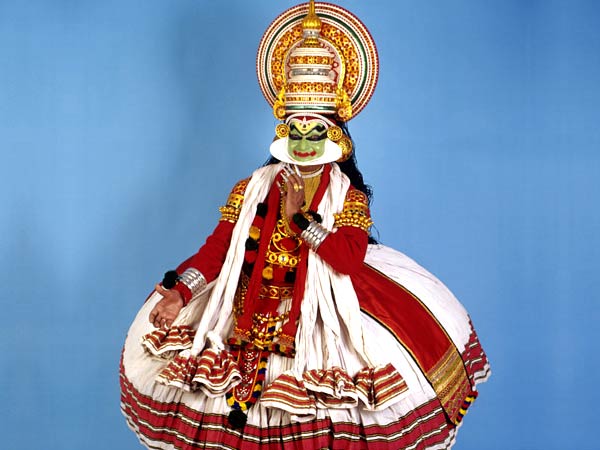Kathakali is the native dance form of Kerala. Read further to know about Kathakali classical dance of India.
Kathakali Dance Form

The picturesque state of Kerala has gifted India with
a dance drama known as Kathakali. Embedded in stories from the epics,
Ramayana, Mahabharata and from the Puranas (ancient scriptures), the
dance form is believed to have originated in the 16th century. Kathakali
can be described as a highly stylized classical Indian dance-drama,
noted for the heavy make-up and stunning costumes of the dancers.
Detailed gestures and well-defined body movements (presented in tune
with anchor playback music and complementary percussion) are some other
notable features of the dance. Elaborate masks, huge skirts and big
head-dresses are uniquely used by the performers of Kathakali.
History
Kathakali is thought to have originated from pioneer dance-drama forms
- Ramanattam and Krishnanattam. The word "attam" means
enactment. These two forms of dance, along with Kathakali, dealt with
presentation of the stories of Hindu Gods Rama and Krishna. Kottarakara
Thampuran, the ruler of the south Kerala province of Kottarakkara,
composed several plays on the Ramayana, which led to the evolution of
Kathakali. Today, Ramanattam and Krishnanattam forms have become
completely extinct, but the story plays continue to be a part of
Kathakali. It originated in the 16th century AD, approximately between
1555 and 1605, and has been improved miraculously over the years.
Long Recitals
Kathakali is emotive as well as narrative in nature and its recitals
are generally very long. This form of dance is usually performed in the
temples. The dancers encompass dance with dialogue and try to bring myth
and legend to life. This dance form is accompanied by drums and
vocalists. The dancers have such strong convictions about the characters
they play that they even swap identities with the legends. Traditionally
the performance begins after sunset and continues till late in the
night. Sometimes, it takes the whole night for one performance to be
complete. Nowadays, due to shortage of time, it isn't rare to see
performances as short as three hours or even lesser.
Three Groups of Performers
Kathakali has three groups of performers, including actor/dancers,
vocalists and percussionists. Without one another is not possible. The
actor or dancers play a variety of roles, including those of kings,
gods, demons, heroines, animals, priests, etc. Each role has a
particular style of makeup and costume as its code. Hand gestures or
mudras, along with extensive facial expressions and eye movements, are
used by the actors to convey their dialogs to the audience. The legend
is narrated in the voice of the vocalists. The instruments consist of
cymbals and 3 types of drums - cena, edakka and maddalam, with each of
the drum producing a distinct sound, used by the third group (of
percussionists).
Renowned Kathakali Training Centers in Kerala
- Kerala Kalamandalam (Cheruthuruthy near Shoranur)
- PSV Natya Sangham (Kottakal near Kozhikode)
- Sadanam Kathakali and Classical Arts Academy or Gandhi Seva Sadan
(Perur near Ottappalam in Palakkad)
- Unnayi Varier Smaraka Kalanilayam (Irinjalakuda south of
Thrissur)
- Margi (Thiruvananthapuram)
- Muthappan Kaliyogam at Parassinikkadavu (Kannur district)
- RLV School (Tripunithura off Kochi)
- Kalabharathi (Pakalkkuri near Kottarakkara in Kollam district)
- Sandarshan Kathakali Kendram (Ambalapuzha)
- Vellinazhi Nanu Nair Smaraka Kalakendra (Kuruvattor)
Kathakali Training Centers Outside Kerala
- The International Centre for Kathakali (New Delhi)
- Santiniketan at Visva-Bharati University (West Bengal)
- Kalakshetra (Chennai)
- Darpana Academy (Ahmedabad)

